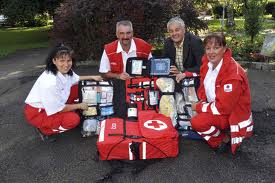Innovation: Idea First Responders
Companies spend a lot of time encouraging their employees to create and propose new ideas. We have training sessions, brainstorming sessions, retreats, team building exercises, ropes courses — you name it and we’ve tried it. So what happens when an employee actually proposes an idea? All too often, we kill the idea before it has a chance to breathe. We don’t do it on purpose. We do it because we’re not properly trained as Idea First Responders™.
An employee proposing a new idea is in a fragile situation. While she may believe it’s a great idea, she’s also unsure how others will respond. Will they like it? Will they support the idea? Or will they dismiss it with a roll of the eyes and a “that’ll never work here” comment. All too often, we suppress ideas without realizing it. If we suppress our employees’ first idea, it’s unlikely that they’ll come back with a second one. Why bother?
In the world of accidents and emergencies, first responders have two critical roles: stabilize and transport. The same thinking can apply to ideas. When an employee proposes an idea, we need to stabilize it and transport it to the next stage of the idea development process.
Stabilizing an idea involves several steps. The Idea First Responder (IFR) may need to flesh out the idea and help the proposer think through its various ramifications. Additionally, the proposer may have lots of questions, including some “dumb” questions. The IFR needs to answer these respectfully. Even a small amount of sarcasm can stifle the entire process. Stabilizing also means encouraging the process. The IFR needs to encourage the proposer to continue to propose new ideas, even if this one doesn’t work out.
The second stage is to transport the idea to the innovation process. This may involve asking the proposer to do more work before moving forward. When the work is completed (assuming it’s satisfactory), the Idea First Responder helps transport it into a more formal process. This may be a weekly staff meeting or it may be a more formal Innovation Committee. During the transport process, the IFR has several critical issues to tend to:
- Who champions the idea? Some proposers will want to present the idea themselves. Others will feel uncomfortable presenting an idea in a formal environment — especially if it involves senior executives. The IFR needs to sort this out. If another person is selected to champion the idea, the IFR needs to ensure that the proposer gets credit for originating the idea.
- Communicating progress. It takes time to develop an idea. The IFR needs to keep the proposer informed. Letting an idea disappear into a black hole only discourages the idea generation process.
- Breaking the good or bad news. If it’s good news, the IFR should ensure that the proposer gets formal, public recognition. If it’s bad news, the IFR needs to let the proposer know why the idea didn’t succeed and continue to encourage the process. “Well, this one didn’t work out, but senior staff really appreciates what you did and hopes you’ll think up more ideas in the future.” A nice note from the CEO can help a lot here.
One Response to Innovation: Idea First Responders
-
Pingback: Innovation: Free Port Rules | Travis White Communications
